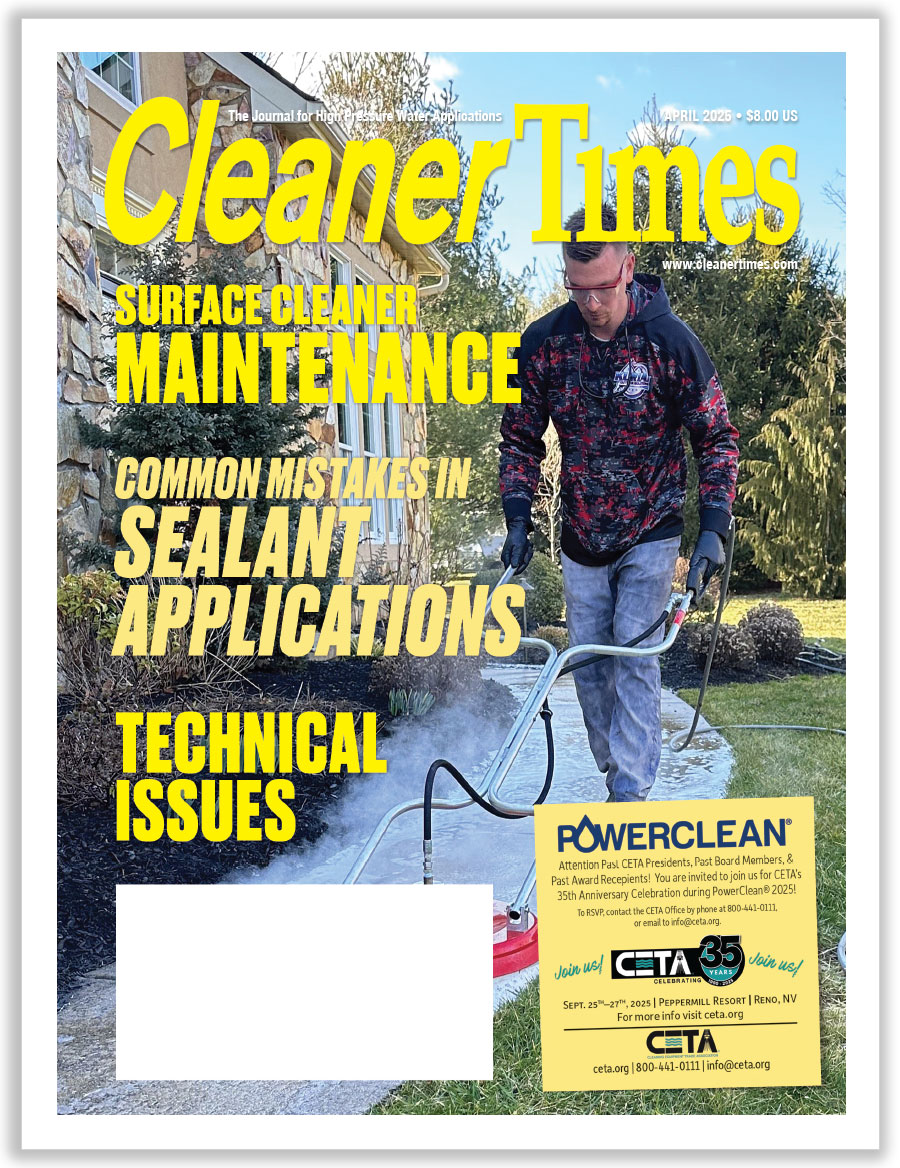
Financial
Diversify to Grow and Profit
By Mark E. Battersby / Published June 2022

In these trying times many pressure cleaning businesses are diversifying in an effort to spur their operation’s recovery or merely to minimize the potential harm from the current economic downturn. Diversification is a strategy whereby a business develops new products or services, or enters new markets, beyond its existing ones.
An operation can diversify into related fields by buying up competitors or suppliers, increasing corporate synergy and overall market share. Alternatively, the operation can move into unrelated fields which will provide a cushion should the current core market weaken.
Although diversification is often a way of building on success, in many cases it may be the key to a business’s survival. First and foremost, pressure cleaning businesses diversify to achieve greater profitability. Of course, Uncle Sam, in the form of our tax laws, will have a say.
What Is Diversification?
At its most simple, diversification is a strategy employed by a pressure washing business to increase its profitability. Expanding into a new segment of the industry in which the business is already operating is one strategy. Expanding into a new field beyond the scope of the operation’s current operation is another. Consider the following:
- Concentric diversification involves adding new products or services to an existing business to attract new customers or clients.
- Horizontal diversification involves providing new and unrelated products or services to existing buyers.
- Vertical diversification is when the pressure cleaning business expands by acquiring another business that operates higher or lower in the supply chain.
- Conglomerate diversification is when the business seeks to develop by adding totally unrelated products, services, or markets to its existing business.
Branching Out
Diversification can provide a pressure washing contractor, distributor, or manufacturer with a way of moving from a failing core market to one of emerging growth. It is not unusual for the owner/operator of a pressure cleaning business to have multiple businesses. In fact, it is quite common.
In today’s tough economy, more and more people are using—or forced to use—their hobbies, sports, or secondary interests to generate income. Beware, however; Uncle Sam, in the form of our tax laws, has quite a bit to say about the cost of starting a new business or expanding an existing one. Those same tax laws are important when it comes to profits, or all-too-often losses, from both new and branched-out operations.
On the plus side, many in the pressure cleaning industry routinely use losses from their secondary activities to offset the income from their existing business. Few realize that the tax laws work both ways in these situations.
The tax rules have long allowed all income from a hobby or spare-time activity to offset or reduce the activity’s expenses. If the activity is operated as a business, however, those same tax laws permit even more of the activity’s expense to be deducted, even to the point where they off-set wages, savings, investment income—and the passed-through profits from the pressure washer’s main business.
Diverse products or services may be attractive to customers, but the tax implications can get complicated. Moreover, with more than one business entity, the tax implications can often mean that the pressure cleaning business is no longer working within the known confines of its own industry.
Keeping It Seperate
If there is more than one activity, care should be exercised on how it is reported to the IRS. In a recent court case, the owners of a business operated as an S corporation, where profits were passed along to be treated as personal income, were also involved in drag racing. They reported the income and expenses of the racing operation on the books of the S corporation.
The IRS disagreed, arguing that the owners merely assigned the racing operation’s income to the S corporation while, in fact, they were separate operations. Not too surprisingly, the courts agreed and ruled that the income had to be reported on the taxpayer’s personal returns as other income.
Starting Up
If, in the beginning, there is a new, unrelated, or hobby business, there are special rules for the expenses incurred in its startup. Anyone incurring business start-up costs that subsequently enters the trade or business can choose to expense and immediately write-off up to $5,000 of those costs. However, the $5,000 deductible amount is reduced dollar-for-dollar when the start-up expenses exceed $50,000.
The balance of start-up expenses, if any, are to be amortized (written-off) over a period of not less than 180 months, starting with the month in which the business begins. It’s another story, however, when a business branches out rather that starting a new business. A pressure washing business that enlarges its existing facility, offers a new but related service or product, or expands usually incurs legitimate, fully tax-deductible expenses.
Expand and Grow
There are a number of ways to expand a pressure cleaning business, including the following:
- Buy out a competitor
- Merge with another pressure cleaning business
- Move to a larger property
- Open additional locations
- Dive into eCommerce, and
- Add complementary products or services
Expansion doesn’t always have to mean “physical.” The so-called “share-of-wallet” concept involves getting current customers to do more business with the operation in different product lines or with additional services.
Making It Work
In addition to the question of what product or service would best complement the pressure cleaning business, an even more important consideration is whether the operation can handle additional business.
Expansion doesn’t always result in an immediate increase in revenue. Labor and capital must be leveraged, but does the operation have sufficient resources in each category?
Regardless of the strategy undertaken, the operation will likely require financing. While interest rates remain low, the bank still needs to approve any needed funding. A well-thought-out business plan and a good credit history are essential in today’s economy.
Yet Another Trap For the Unwary
Our voluminous tax rules limit the deduction for losses from so-called “passive activities.” Generally, losses from passive activities may not be deducted from non-passive income (for example, wages, interest, dividends—or profits from the principal business).
A passive activity is one that involves the conduct of any trade or business in which the taxpayer does not materially participate. Materially participating can be measured in a number of ways, including putting in more than 500 hours each year. Materially participating also occurs when the individual’s participation constitutes substantially all of the participation in the activity.
More Caveats
Whether starting a new and hopefully related business or simply growing, there are a number of potential trouble spots that deserve attention. For example, can the current operation adapt to provide additional services or products?
Or, perhaps, the current product or service could evolve in a small way without doing something completely different?
Is there a new audience or audiences that could be reached either from the present location or from a new location? Will any of the contemplated efforts alienate existing customers or clients?
Suppose, for example, that the business remains the same, offering the same products or services, but changes the way those products or services are brought to its existing customers or clients. This strategy helps the pressure cleaning operation to better meet the needs of its already existing customers or clients. Consider the following items:
- Changing the operation’s processes—Minor changes might involve basic processes allowing delivery of the same products or services in a more efficient or recipient-friendly manner.
- New systems—Often diversification can be as simple as improving the manner in which the operation does business—a new computer system to better track sales, inventory, schedules, etc.; new equipment; or a more efficient and customer-friendly layout of the equipment distributor’s premises.
- A new location—If customers can’t come to the operation’s present location, taking the services or products to them opens new opportunities.
- Online—Brick-and-mortar businesses have diversified by eCommerce websites to promote and sell their services or products.
- Link-ups—Can the pressure washing operation link up with another business to provide a more comprehensive service?
In The End
The advantages of diversification are well known. Serving multiple markets, providing new services or products, moving to a new location, or acquiring a competitor are among the strategies that can help a pressure cleaning business grow. Diversification, as risky as it can be, may also be a great way to increase the operation’s profitability.
Although in many cases diversification is simply a way of building on existing resources, at other times it has proven necessary for the pressure washing operation’s survival. Diversification, therefore, can offer a business a way of moving from a failing core operation to one of emerging growth.
Diversification must, of course, be well thought out. It can boost the growth of the pressure cleaning business by leading it towards profit maximization. However, it can also prove to be a costly failure. A detailed analysis of any diversification strategy must be conducted before opting in to the potential for growth. Professional advice can reduce risk while increasing the possibility of success.





